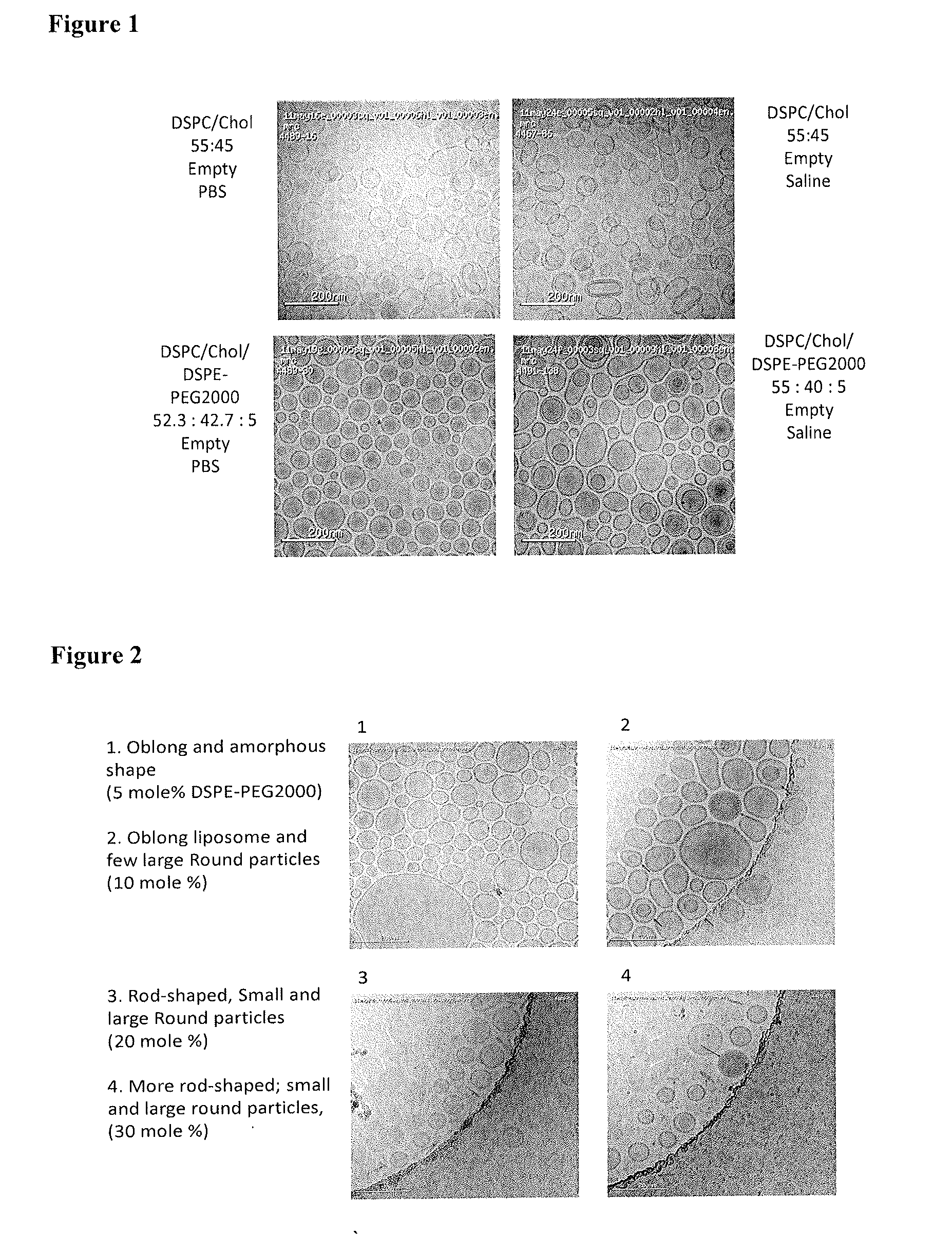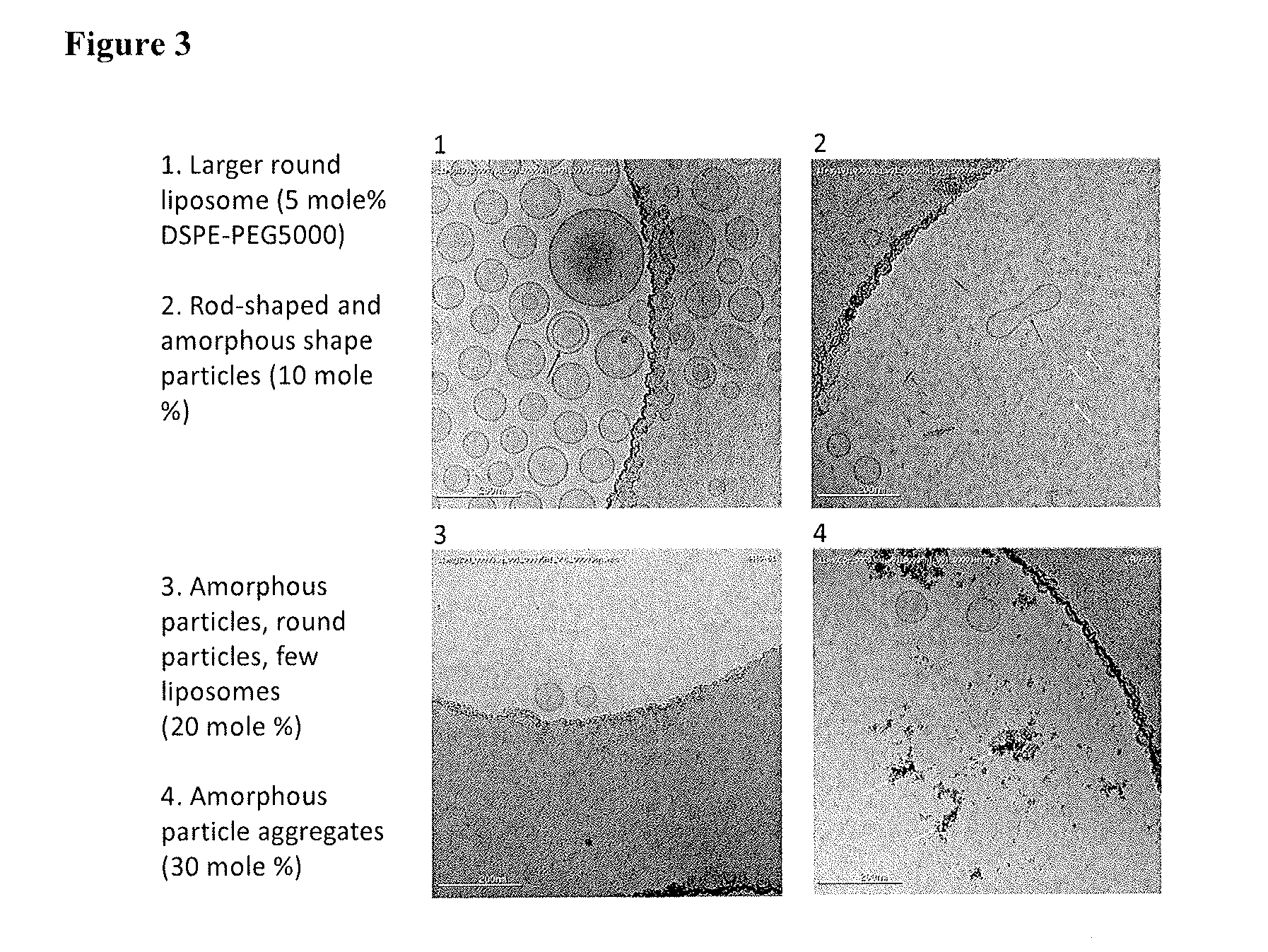Liposomal cisplatin compositions for cancer therapy
a technology of liposomal cisplatin and compositions, which is applied in the field of liposomal cisplatin compositions for cancer therapy, can solve the problems of high-end hearing loss, toxicity of platins, kidney and nerve damage,
- Summary
- Abstract
- Description
- Claims
- Application Information
AI Technical Summary
Benefits of technology
Problems solved by technology
Method used
Image
Examples
example 1
General Methods for Preparation of Liposomal Cisplatin Compositions
[0065]Encapsulation of cisplatin in liposome was carried out by solvent dilution method. Lipid mixtures (500 mg portions of varying lipid ratios) were dissolved in 1 mL t-BuOH / EtOH (1 / 1, v / v ratio), or t-BuOH / EtOH / water (49 / 49 / 2 v / v ratio), and heated at 70° C. until clear. 90 mg cisplatin was dissolved in 9 mL of buffer (145 mM NaCl, 10 mM histidine buffer pH 6.5) at 70° C.). The lipid solution was added to the cisplatin solution with rapid mixing to form multi-lamellar vesicles (MLVs). The MLVs were passed through two stacked 80 nm polycarbonate filters using a L1PEX™ Extruder (Northern Lipid Inc.) heated to 70° C. The vesicle size and size distributions were determined by using a particle size analyzer based on quasi elastic light scattering principle (QELS) following each pass, and the extrusion was stopped after a mean volume diameter of 90-120 nm was achieved. Following extrusion, the liposomes were diluted 10-...
example 2
Liposome Morphology Varies with PEGylated Lipid Content
[0067]A series of liposomes containing DSPC, cholesterol, and DSPE-PEG(2000, or 5000) were prepared. The ratio of DSPC / Cholesterol was fixed at 55 / 45 (mole %), and the PEGylated lipids were 0, 5, 10, 20, 30 mole % of the total lipid compositions respectively. The liposome compositions are shown in Table 1. The cryo-TEM images are shown in the following FIGS. 1, 2, and 3. These images clearly indicate that the liposome morphology varies with the level of PEGylated lipid in the liposome. Beyond about 5 mole %, essentially, liposomes were unstable and large disk-shape particles were formed. Levels greater than 7 mole % led to particularly high morphological heterogeneity.
TABLE 1Liposome Compositions for Morphological Study by Cryo-TEMDSPE-PEGDSPCCholesterol(2000, 5000)Mole %Mole %Mole %TEM Images55450FIG. 155405FIG. 1 (PEG2000),52.2542.755FIG. 1 (PEG 2000), 2 (PEG2000),3 (PEG 5000)49.540.510FIG. 2 (PEG 2000), FIG. 3(PEG 5000)44.036...
example 3
Preparation of Liposomes with Various Phospholipids
[0068]A series of 14 liposome samples were prepared according to the method described above. The liposome compositions are listed in Table 2. For comparison purposes, Sample 1 was prepared according to Example 5 in U.S. Pat. No. 6,126,966 (SPI-077 composition). Samples 3, 4, 14 and 10 were prepared using DSPC phospholipids with cholesterol levels that ranged from 0 mole % to 40 mole %. Binary mixtures of DSPC and DPPC were used in Samples 5-9. Samples 5, 6, and 7 had higher cholesterol levels (30-40 mole %), and Samples 8-9 had lower cholesterol levels (10-20 mole %). Sample 10 was prepared using DSPC as the main phospholipid component for specific comparison with Samples 1 and 2, in which HSPC was used. Samples 11 and 12 were prepared using DPPC and DMPC as the main phospholipid components, in which DMPC has a fatty acid chain of 14 carbon atoms. Sample 13 used POPC as the main phospholipid component, in which the fatty acid chains...
PUM
 Login to View More
Login to View More Abstract
Description
Claims
Application Information
 Login to View More
Login to View More - R&D
- Intellectual Property
- Life Sciences
- Materials
- Tech Scout
- Unparalleled Data Quality
- Higher Quality Content
- 60% Fewer Hallucinations
Browse by: Latest US Patents, China's latest patents, Technical Efficacy Thesaurus, Application Domain, Technology Topic, Popular Technical Reports.
© 2025 PatSnap. All rights reserved.Legal|Privacy policy|Modern Slavery Act Transparency Statement|Sitemap|About US| Contact US: help@patsnap.com



